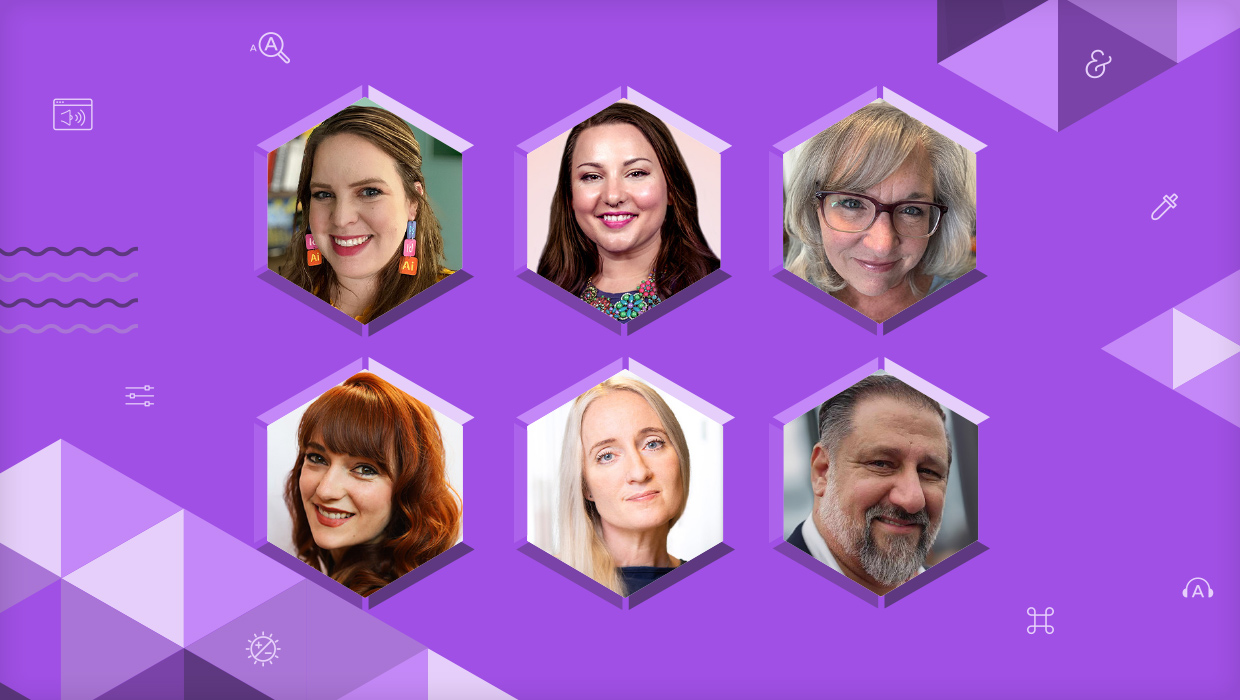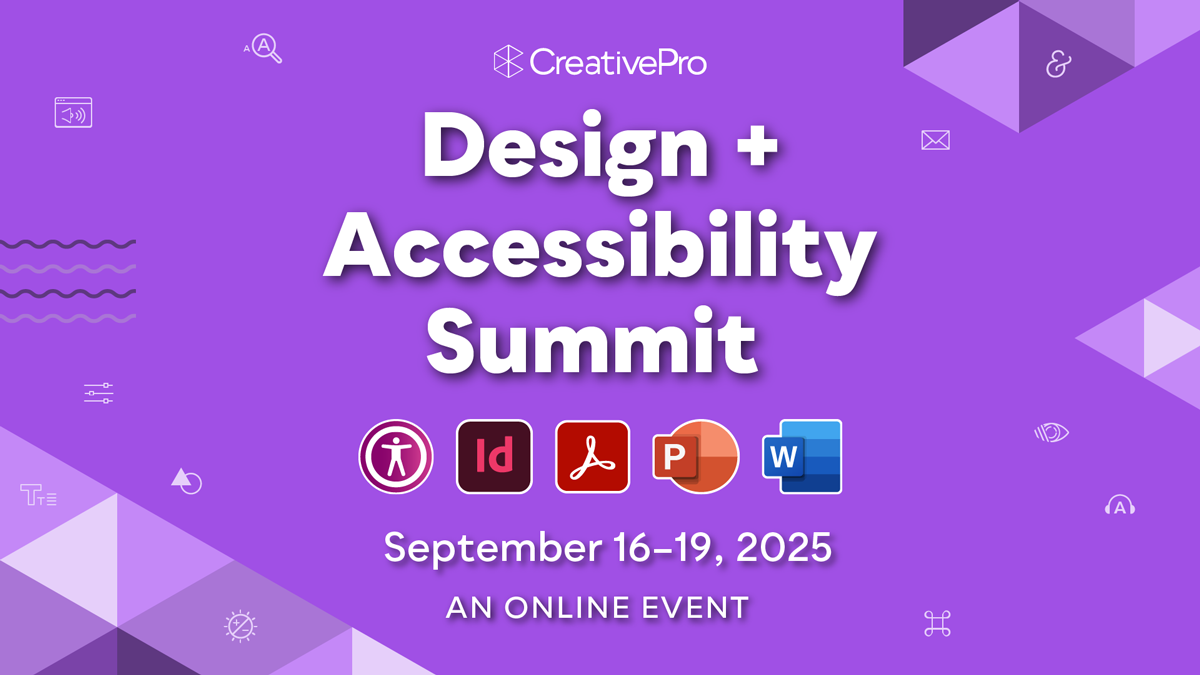Event Overview
This event is ended, but is available for on-demand purchase through December 19. On-demand access ends September 19, 2026.
Join us at the 6th annual Design + Accessibility Summit, the essential how-to event for design professionals who need to master accessibility, being held online September 16–19, 2025.
It’s no secret that accessibility is a hot topic. In fact, ensuring your content is accessible is not just a good idea: it’s the law. Whether you’re extending your company’s DEI (Diversity, Equity, Inclusion) focus, expanding your market to include the estimated 25% of the population who have disabilities, or safeguarding your company against legal risks, it’s important to make accessibility a business priority.
Creative professionals must learn how to design content that is accessible for people with vision and hearing impairments, mobility and cognitive challenges, or other disabilities. Those who develop expertise in accessibility will find themselves in high demand; while those who don’t will risk falling behind.
At The Design + Accessibility Summit, you will learn practical techniques for building accessible assets with InDesign, Acrobat, PowerPoint, and other tools widely used by creative professionals.
Can’t join us live? Don’t worry, we’ve got you covered. . .
Registration includes on-demand access to session and Q&A recordings for a full year, so you can absorb the knowledge at your own pace.
What We'll Cover
- Get up and running with accessibility essentials
- The Word to InDesign to Acrobat PDF workflow
- Step-by-step testing with a screen reader
- Designing content for low visual acuity and screen readers
- Making social media accessible
- Understanding Section 508 vs. ADA compliance and WCAG guidelines, for both U.S. and international accessibility laws
- PDF remediation: The step-by-step process for ensuring compatibility
- How to write and present with accessibility and inclusion in mind
- Making sense of tags, alt text, and reading order
- Building accessible tables, forms, and infographics in InDesign and other tools
- Is your website accessible?
- AI + Accessibility = a bright future for human accessibility
- Building accessible PowerPoint and Word documents suitable to share with clients and your team
- Accessibility tools every designer needs to know
Get a Taste
Editor’s Picks for The Design + Accessibility Summit 2025
Our Editor in Chief lists his must-see sessions for The Design + Accessibility Summit 2025.
How to Design Button States for Accessibility
Learn how to create accessible button states for web design, while keeping them eye-catching, functional,…
Interview with Caroline Desrosiers, Alt Text Entrepreneur
Q&A with Caroline Desrosiers, who is presenting at The Design + Accessibility Summit 2025
How to Make Alternate Text Styles in Microsoft Word
Working in Microsoft Word? Shawn Jordison shows you how to spruce up your documents with…
Interview with Colleen Gratzer, Accessibility Specialist
Q&A with Colleen Gratzer, who is presenting at The Design + Accessibility Summit 2025
Who You’ll Learn From
Get real-world answers to your toughest design challenges from our industry-leading experts.
Why Attend
See why The Design + Accessibility Summit needs to be in your 2025 plans now!
Master Practical Accessibility Skills
Learn exactly how to create accessible PDFs, PowerPoints, Word documents, social media posts, websites, and more with step-by-step techniques you can apply immediately.
Make Accessibility Your Competitive Advantage
Accessibility isn’t just the right thing to do—it’s a business essential. Expand your reach, meet legal requirements, and position yourself and your company as leaders in inclusive design.
Stay Ahead of the Law—and the Market
Get expert guidance on Section 508, ADA, WCAG, and international accessibility standards, helping your organization stay compliant, avoid legal risks, and serve a wider audience.
Year-Round Learning
With a full year of on-demand access to sessions and speaker resources, you’ll be equipped to apply new skills right away—and keep building your expertise long after the event ends.
Need to convince your boss?
Download our Convince Your Boss kit today—it contains our 2025 PDF brochure and an email letter template you can personalize.
“The event helped me understand accessibility standards as a designer, but also showed the real-life situations where accessibility is crucial.”
— Racheal Cowley Graphic Designer, Memory Tree“I was immediately able to implement practical changes to the accessibility of our communications materials after this conference.”
— Peggie Bobo Strategic Communications Manager, TEAM UP, Boston Medical Center“I was impressed by the quality of the speakers and their presentations…the content comes from folks with the knowledge, skills, and experience that lend credibility to what they say.”
— John Lee Assistive Technology Specialist, Cal Poly“It was eye opening to hear from different perspectives trying to achieve accessibility for all. I learned about new insights, skills, and tools to better my understanding of what it means to design for everyone.”
— Min Yang Senior Graphic Designer, Quality Information Partners“CreativePro conferences are always top notch. I would consider my 508 compliance knowledge intermediate level, and I learned at least one mind blowing thing each day!”
— Christa Pijacki Technical Editor/508 Compliance Specialist, HNTB Corporation“I felt a new sense of purpose for my career by focusing on accessibility and how I can help make the world a more accessible place for all.”
— David Gries Graphic Designer and Digital Media Specialist, MESSASpecialistOn-Demand Registration Details
One year of on-demand access
to all session and Q&A session recordings for the days your pass covers. Ends September 19, 2026.
Speaker handouts
and resources from the world’s top experts
Alumni discount
on future live and online CreativePro events
Free downloadable copy of The CreativePro Accessibility SuperGuide
our nearly 100-page compendium of essential knowledge, tools, and techniques for producing accessible documents.
Get a taste of this amazing downloadable resource with our free sampler
Certificate of Participation
Pricing
All prices are in USD. CreativePro Member discount cannot be combined.
| Pass Type | CreativePro Members | Non-Members |
|---|---|---|
| 1-Day Pass | $495 | $495 |
| 2-Day Pass | $620 | $745 |
| 3-Day Pass | $870 | $995 |
| 4-Day Pass | $1,070 | $1,195 |
Discounts and Group Registrations
- Students, faculty, non-profits, and government agencies can receive a $100 discount off any multi-day pass.
- CreativePro Members can receive a $125 discount off any multi-day pass.
- Alumni of CreativePro events can receive a $150 discount off any multi-day pass.
- Groups of three or more can receive a $50 discount for each attendee they register.
- Discounts cannot be combined (including CreativePro member discount). Discounts cannot be added after you have registered.
- Please contact us here for discount information prior to registering.
Substitutions
- You may transfer your registration to another person by writing Marci on our Contact Us page. Your request must include your name and e-mail address as well as that of the person who will now be attending in your place. Once we receive this information, a confirmation letter will be sent to the new attendee.
- If you need any other information after reviewing this page, please contact us here.
All times are listed in Pacific timezone.
Click here to download the printable agenda PDFDay 1:
Tuesday, September 16, 2025
Accessibility Essentials: Core Principles for Every Designer
This session covers an overview of digital accessibility, including the range of disabilities that impact users and the essential terminology and acronyms used in the field. We’ll also touch on core accessibility principles, popular assistive technologies, and key tools and resources that every designer should have in their toolkit.
Key Takeaways:
- Understand the primary types of disabilities—physical, cognitive, neurodivergent, hearing, and vision—and how each affects the user experience.
- Understand essential accessibility terminology and acronyms to engage in future sessions and apply them in your designs.
- Learn core accessibility principles that guide inclusive design, including perceivability, operability, and navigability.
- Recognize the role of assistive technologies in supporting users with disabilities and how to design with them in mind.
- Understand the importance of creating designs that are accessible to all, laying the groundwork for more technical accessibility approaches.
WCAG and PDF/UA Walkthrough: Simplifying the Standards
In this session, we’ll break down the key WCAG (Web Content Accessibility Guidelines) and PDF/UA (PDF/Universal Accessibility) standards, translating their complex requirements into clear, designer-friendly language. You'll learn how these guidelines shape the way we design digital and document experiences to be accessible to all users, regardless of ability. We’ll focus on the real-world impact behind each standard and provide actionable insights to help you implement accessibility in your projects with ease. We’ll also explore the overlap between WCAG and PDF/UA, helping you see how the two standards work together to create a more inclusive experience. By the end, you’ll have the knowledge and tools to integrate accessibility seamlessly into your design process.
Key Takeaways:
- Understand the core principles of WCAG and PDF/UA and how they guide accessible design practices.
- Learn the key guidelines from both standards and how they can directly improve your digital and document design.
- Identify the overlap between WCAG and PDF/UA, and discover how to streamline your design process by applying both standards together.
- Gain practical, easy-to-follow tips to implement accessibility features—from color contrast to text formatting—in your daily design workflow.
- See the real-world impact of accessibility, with examples showing how these standards enhance user experiences for everyone.
Accessible Social Media Content and Dash of AI
Discover how to create social media content that's accessible to everyone—no matter their ability, device, or environment. We'll dive into the different ways users engage with social media, from scrolling without sound to using screen readers, and how to meet them where they are. Learn simple, time-saving strategies like adding alt text and captions to ensure your content is inclusive without adding hours to your workflow. Plus, we'll explore how AI can streamline tasks like formatting and reviewing video captions. By the end of the session, you'll walk away with platform-specific tips and a ready-to-use accessibility checklist for every post, story, video, and campaign.
Key Takeaways:
- Learn how to design accessible social media content that works for all users, regardless of ability or environment.
- Discover free tools and easy steps for your workflow.
- Understand how AI can assist with accessibility tasks, especially for video captions and formatting.
- Gain platform-specific tips for social media accessibility across various platforms.
- Walk away with an accessibility checklist to ensure your content is inclusive every time you post.
Legal Aspects of Accessibility Risk and Compliance
This session will cover the legal requirements for accessibility, including an overview of key laws like WCAG, ADA, and Section 508. Among the topics covered will be the risks of non-compliance, including potential fines, legal action, and damage to brand reputation. We will also discuss the intersection of accessibility and disability rights, and touch on how accessibility is enforced to provide strategies for avoiding legal pitfalls.
Above Compliance: The Art of Color Contrast
Color contrast is more than just meeting the minimum standards. It’s about optimizing your design for real-world user experiences. In this session, we’ll take an AA-compliant color palette and elevate it using techniques that go beyond the basics. You’ll learn how to test, refine, and ensure your designs are both accessible and visually engaging, no matter the device or viewer’s needs.
Key Takeaways:
- Apply WCAG Level AAA contrast standards for a safer, more inclusive design.
- Use Bridge APCA Light Contrast testing to evaluate font and background pairings, especially for dark mode.
- Simulate color blindness to better understand how users with different visual impairments experience your design.
- Learn the importance of supporting color meaning with text and graphics, following WCAG 1.4.1 guidelines.
- Gain practical tips for testing and improving color contrast in a variety of environments.
Accessibility + AI: A Designer’s Dilemma
Artificial Intelligence (AI) is reshaping the way we design and interact with digital experiences, bringing both opportunities and challenges for accessibility. In this session, we’ll explore how AI is being leveraged by disabled individuals as assistive technology and how AI-powered design tools can help create more inclusive products. We’ll also examine critical concerns surrounding AI, such as bias, reliability, and over-dependence. By the end of this session, you’ll have a better understanding of how to navigate the intersection of AI and accessibility, ensuring that your design processes remain inclusive while addressing potential risks.
Key Takeaways:
- Discover how AI is empowering individuals with disabilities and transforming assistive technology.
- Learn how AI-powered can support the creation of accessible content, designs, and user interfaces.
- Understand the ethical concerns surrounding AI, including bias, reliability, and dependency, and how they impact accessibility.
- Learn practical strategies for integrating AI responsibly into your design workflows to ensure accessibility remains a priority.
Day 2:
Wednesday, September 17, 2025
Microsoft Word to Accessible PDF
Learn how to create fully accessible Microsoft Word documents, a crucial first step in ensuring your content reaches everyone. Whether you're new to accessibility or an experienced designer looking to refine your skills, this session will cover best practices for document structure, Section 508 requirements, and the essential steps for converting Word files to accessible PDFs. You'll gain hands-on knowledge of Word’s built-in accessibility tools, such as the Accessibility Checker and the Accessibility Assistant, and learn how to effectively use styles, headings, and metadata to enhance document accessibility. By the end of this session, you’ll be equipped to design documents that are both user-friendly and legally compliant.
Key Takeaways:
- Learn how to apply Section 508 requirements and accessibility best practices for formatting and structuring Word documents.
- Master the art of using Word's built-in styles and features to create accessible, well-organized content.
- Discover how to convert Word documents to accessible PDFs and ensure compliance with accessibility standards.
- Understand how to use accessibility tools like the Accessibility Assistant and the Accessibility Ribbon to test and enhance document accessibility.
- Gain confidence in navigating the complexities of accessibility standards, including WCAG, Section 508, and PDF/UA.
Readability: Accessibility’s Quiet Partner
In this session, we explore readability—an essential yet often misunderstood aspect of inclusive design. More subjective than accessibility and harder to quantify, readability is no less important. Learn how your font choices—and particularly the way you handle those fonts—affect more than style; shaping how quickly and comfortably text can be read.
Topics covered:
- What is readability, and how does it differ from legibility?
- The role of x-height, counter shapes, and stroke contrast in creating readable type.
- The Goldilocks zone of line length: not too long, not too short—the cognitive sweet spot for comfortable reading.
- Line spacing (leading): how to tailor it to font style, type size, line length, and reading context.
- Alignment and word spacing: how layout decisions affect rhythm, flow, and where the “extra space” goes.
Foundations of Accessibility in InDesign
Creating accessible documents in Adobe InDesign starts with understanding the essential building blocks of accessibility. This session will walk you through the key elements of accessible design in InDesign, beginning with setting up a document right from the start and adding proper text styles to provide a clear content hierarchy. We'll also explore processes for adding alt text and metadata, creating a table of contents, and managing reading order to make your InDesign documents accessible and user-friendly. Whether you're a beginner or looking to refine your skills, this session will provide practical tools and tips for designing documents that are truly accessible.
Key Takeaways:
- Understand the importance of text styles and setting appropriate tags for accessibility.
- Learn how to create a structured document hierarchy for optimal accessibility.
- Discover the process of adding alt text and metadata, including automating these tasks for efficiency.
- Master how to create a table of contents for interactive and print PDFs.
- Learn strategies for preventing style overrides, handling reading order, and using the Articles panel for complex documents.
Beyond the Basics: Advanced Accessibility in InDesign
Adobe InDesign offers unmatched control for creating accessible PDF files, and mastering its advanced features can take your accessibility game to the next level. This session offers a deep dive into the hidden capabilities of InDesign that go beyond the Accessibility Checker. From leveraging metadata for SEO to automating alt text extraction, we’ll explore tools and techniques that ensure your documents are fully accessible and compliant. Learn how to tag images, tables, and custom elements effectively, and discover shortcuts that streamline your workflow. Whether you're a seasoned InDesign user or just starting to explore its accessibility features, this session will help you take full advantage of InDesign’s power to create truly accessible documents.
Key Takeaways:
- Master advanced features in InDesign to create fully accessible PDFs, from metadata to alt text automation.
- Learn how to use styles and preflight settings to ensure consistency and compliance throughout your documents.
- Discover how to handle tables, captions, and custom bullets for optimal accessibility.
- Explore the importance of testing with assistive technologies and how to identify issues beyond what the accessibility checkers catch.
- Streamline your workflow with keyboard shortcuts and the Preflight panel to speed up your accessibility tasks.
Accessible Design Tactics for PowerPoint
The Accessibility Checker in PowerPoint is a great starting point—but it only scratches the surface of what makes a presentation truly inclusive. In this session, we’ll explore real-world accessibility challenges like flattened graphics, non-editable charts, and hard-to-read layouts. You’ll learn how to spot barriers that the checker can’t catch, how to use the tools PowerPoint does offer more effectively, and how to make smart, audience-focused design decisions when you’re working with less-than-ideal content. Whether you’re cleaning up someone else’s slides or trying to improve your own, youll walk away with practical techniques, a clear understanding of the checker’s capabilities, and the confidence to make better design choices that serve everyone.
Key Takeaways:
- What the PowerPoint Accessibility Checker does well—and where it falls short
- Workarounds for inaccessible elements like image-based charts and graphic-heavy layouts
- Tips for using built-in tools (like the Selection Pane, reading order view, and alt text fields) to troubleshoot and improve accessibility
- How to evaluate and improve templates and externally designed slides without losing brand fidelity
- Downloadable “Accessibility Rescue Kit” with checklists, common fixes, and alt text guidance
How to Test Documents for Accessibility
Testing documents for accessibility is a critical step in creating content that’s inclusive for all users. In this session, we’ll walk through the essential steps to ensure your documents are compliant, accessible, and offer a positive user experience. We’ll review how to use a combination of document checkers and a screen reader to go beyond a simple pass/fail accessibility test. You'll learn key shortcuts and techniques to catch common accessibility issues in your documents. Whether you're working with PDFs or other document formats, this session will help you establish an efficient, thorough testing process to ensure your content is truly accessible.
Key Takeaways:
- Discover the key steps to ensure document accessibility and compliance with real-world tools.
- Learn how to use assistive technology to test your documents.
- Go beyond pass/fail compliance checks to evaluate the overall experience for all users.
- Master efficient testing workflows and shortcuts that save time while improving document accessibility.
- Identify common accessibility issues and what the checkers miss.
Day 3:
Thursday, September 18, 2025
Accessible Web Design Systems for Everyone
Design systems are powerful tools for scaling consistent and efficient web design. Integrating accessibility from the start ensures all users are considered. This session covers the key principles and techniques for embedding accessibility into your design systems. You’ll learn how to create accessible components and patterns, utilize document accessibility guidelines, and hand off your system with accessibility in mind. Learn how to create designs that not only look great, but work for everyone. We’ll show you Figma tools designed to help you build accessible systems. Whether you’re creating a new system or enhancing an existing one, you’ll leave with actionable strategies for making accessibility part of your design system’s DNA.
Key Takeaways:
- Learn how to integrate accessibility standards directly into your design system in Figma.
- Create reusable, accessible components that scale across products and platforms.
- Develop documentation that empowers designers and developers to consistently apply accessibility.
Making Accessible Ebooks from InDesign
In recent years, updates to InDesign have significantly upgraded the program’s ability to make accessible EPUBs. In this hands-on session, we will look at those improvements and how to work the gears to get the best possible ebooks from print layouts. We will cover topics like metadata, robust structure and navigation, image descriptions, and semantics.
Key Takeaways:
- Writing useful accessibility metadata
- Understanding TOC styles
- How to create a page list
- The role of semantics in well-made content
Making Accessible Audio and Video
Make your audio and video content accessible to all with simple, actionable techniques. In this session, we’ll cover the essentials of creating transcripts, closed captions, open captions, and audio descriptions. We’ll discuss best practices for presenting these accommodations and how they benefit both disabled and non-disabled audiences. You’ll also discover affordable and free tools that can help you enhance the accessibility of your content without a hefty budget.
Key Takeaways:
- Understand the value of closed and open captions for people with hearing loss or auditory processing challenges.
- Learn how audio descriptions make video content more accessible for individuals with partial or complete vision loss.
- Explore free and affordable tools for creating high-quality captions, transcripts, and audio descriptions.
Neuro-Inclusive Design: Reducing Cognitive Barriers
How do your designs help (or hinder) people with different ways of thinking, focusing, and feeling? For users who are neurologically different, thoughtful design can make the difference between clarity and overwhelm. In this session, you’ll learn how to create designs that work for neurodivergent audiences, supporting users with ADHD, autism, dyslexia, and more, without sacrificing creativity. We’ll show you how to apply these insights to create more inclusive experiences. You’ll leave with an actionable checklist and fresh insights you can apply to websites, interfaces, documents, and multimedia, helping you design experiences that welcome every mind.
Key Takeaways:
- Understand what neurodivergence means (and what it doesn’t)
- Identify how cognitive load, executive functioning, and sensory input to shape user experience
- Apply practical design strategies to reduce overwhelm, improve clarity, and support focus
Optimizing Workflows for Better Alt Text
Alt text is not just a requirement—it's the result of a creative, collaborative process that works best when you make it part of your content and design workflows from the start. In this session, we will shift the focus from how to write alt text to how to build the systems and partnerships that make great alt text possible. You’ll learn how design, marketing, and product teams can co-create processes that generate meaningful alt text, turning visuals into rich, discoverable content experiences. We will also examine where AI fits into the process, accelerating production without sacrificing the human insight needed for accuracy and nuance.
Key Takeaways:
- Alt text is a creative and strategic asset, not just a compliance task, and works best when developed early through cross-functional collaboration.
- AI can support scalable alt text workflows, but human review is key to quality and brand alignment.
- When integrated into content and design systems, alt text enhances not only accessibility but also SEO, content discoverability, and user engagement.
Designing Accessible Infographics and Data Visualizations
This session will explore the principles and techniques for creating accessible infographics and data visualizations for both print and web. We’ll focus on critical aspects such as color, labeling, alt text, and interaction patterns. Attendees will learn practical strategies for designing data that is inclusive and easy to understand. You’ll discover how to use color-blind-safe palettes, incorporate clear labeling and iconography, and ensure readability across various environments. Attendees will leave with actionable strategies and tools to design data that is both equitable and impactful.
Key Takeaways:
- Use patterns, icons, and clear labels to ensure charts are color-blind friendly.
- Maintain text legibility by scaling appropriately and separating text from the chart.
- Ensure sufficient contrast in graphical elements and text to meet accessibility standards.
- Provide alternative ways to access data, such as alt text, data tables, and CSV downloads.
- How to add metadata for accessibility in Illustrator.
Day 4:
Friday, September 19, 2025
Getting Started with Acrobat PDF Remediation
Ready to make your PDFs fully accessible? Whether you're just starting out or looking for a refresher, this session will guide you through practical, step-by-step techniques for Acrobat PDF remediation. You’ll discover how to use Acrobat’s powerful built-in tools to identify and fix common accessibility issues like missing tags, improper reading order, and untagged images. With a hands-on approach, we’ll walk through the essentials—navigating the tags tree, fixing table structures, and adjusting reading order.
This session is perfect for beginners and offers valuable tips for more experienced users who want to streamline their remediation process. You’ll leave with clear, actionable steps to start remediating PDFs confidently, without the overwhelm.
Key Takeaways:
- Understand how to identify and fix common PDF accessibility issues.
- Learn to walk the tags tree and correct the document structure.
- Gain confidence in using Acrobat’s tools to ensure your PDFs are accessible.
Tables and Assistive Technology: A Screen Reader’s Perspective
Did you know that screen readers utilize specialized navigation and reading keyboard commands for use with tables? For example, screen readers have settings for how Table Headers (column and row titles) are read to us. And tables can be “uniform” or “non-uniform” depending on the use of merged or split cells. These tools can help, but our ability to understand the data in tables is largely dependent on how the table is designed and used in the document. This session demonstrates some of the basic keyboard command navigation and reading techniques you should know for working with assistive technology.
Key Session Takeaways:
- An understanding of how screen readers work in tables
- Basic keyboard navigation and reading commands
- The differences between the JAWS and NVDA screen reader
Accessible Table Structures That Work
Tables are a crucial tool for presenting data, yet they can become barriers if not structured properly for accessibility. In this session, we’ll showcase several tables that have accessibility issues and demonstrate how to restructure them for improved usability. You’ll learn best practices for creating accessible tables, including how to use headers, data relationships, and navigation strategies. We’ll focus on how to ensure your tables are functional and accessible for all users, not just those using a screen reader. By the end of the session, you’ll know the key properties that make a table accessible and what to avoid.
Key Takeaways:
- Identify common accessibility issues in table design and how to design around them.
- Learn the importance of headers, rows, and columns to create a clear structure for screen reader users.
- Discover ways to improve table navigation for all users.
- Gain insights on the importance of structure and order for table data.
- Receive actionable steps to design tables with better accessibility baked in from the start.
Creating User-Friendly Accessible Forms in InDesign
Creating accessible fillable PDF forms doesn’t have to be overwhelming. In this session, we’ll show you how to design forms in Adobe InDesign with accessibility in mind, ensuring that your documents are usable by everyone. You’ll learn how to create fillable fields, add descriptions, and handle tag structures effectively. We’ll explore methods for creating accessible forms directly in InDesign and address common challenges in Adobe Acrobat. By the end of the session, you’ll be equipped with practical strategies to design, export, and test accessible forms that meet accessibility standards without sacrificing form functionality or design integrity.
Key Takeaways:
- Learn how to create accessible fillable PDF forms directly in InDesign.
- Understand the importance of tooltips (field descriptions) and how to add them for full accessibility.
- Discover how to address tag structure and form field order for compatibility with assistive technology.
- Gain insights on exporting forms to a tagged PDF with all necessary accessibility features in place.
Building Your Document Accessibility Toolkit
Creating and testing accessible digital content requires the right tools. This session will introduce you to a wide range of tools designed to streamline the creation, remediation, and testing of accessible content across platforms. You’ll learn how to use tools like Made2Tag, CommonLook, and AxesPDF for accessible PDF creation and remediation. We’ll also cover color contrast analyzers, screen readers, and disability simulators. You’ll walk away with the knowledge to integrate these tools into your workflow for improved accessibility and compliance. This session will empower you to create content that is accessible to everyone, regardless of ability.
Key Takeaways:
- Discover tools for accessible document creation and remediation.
- Explore color contrast analyzers and simulators to ensure your designs are visually accessible.
- Gain insights into free and paid tools for creating accessible color palettes.
Getting Buy-in From Your Employer
Are you struggling to get buy-in for accessibility from leadership at your organization? This session goes beyond generic advocacy and dives into the strategic motivators that drive executive decisions. You’ll learn how to tailor your accessibility pitch based on the values that matter most to your leadership—whether it’s reducing legal risk, increasing revenue, aligning with social values, or future-proofing your brand. We’ll walk through a four-pillar framework and arm you with targeted questions and data points to build a strong, customized business case that gets results.
Key Takeaways:
- Discover the four key motivators that influence executive decision-making around accessibility: risk, income, justice, and sustainability.
- Learn how to frame accessibility as a strategic advantage, not just a compliance task.
- Gain practical questions to assess your organization’s readiness and identify gaps in your current approach.
- Receive powerful talking points tailored to different C-suite priorities so you can build stronger internal support.
Discounts and Group Registrations
- Students, faculty, non-profits, and government agencies can receive a $100 discount off any multi-day pass.
- CreativePro Members can receive a $125 discount off any multi-day pass.
- Alumni of CreativePro events can receive a $150 discount off any multi-day pass.
- Groups of three or more can receive a $50 discount for each attendee they register.
- Discounts cannot be combined (including CreativePro member discount). Discounts cannot be added after you have registered.
- Please contact us here for discount information prior to registering.
Substitutions
- You may transfer your registration to another person by writing Marci on our Contact Us page. Your request must include your name and e-mail address as well as that of the person who will now be attending in your place. Once we receive this information, a confirmation letter will be sent to the new attendee.
- If you need any other information after reviewing this page, please contact us here.























